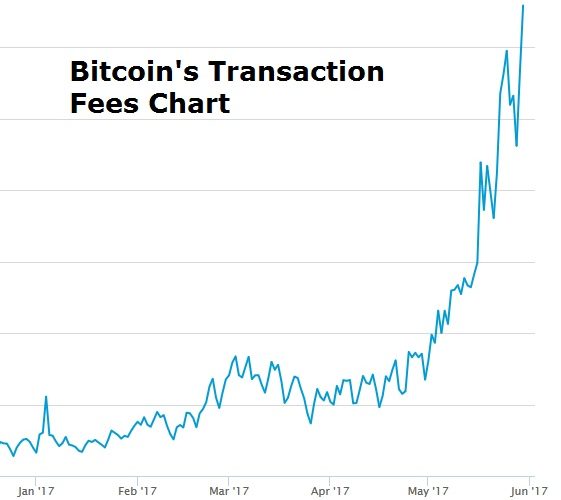Fixing the transaction fee problem

If you view each crypto currency as a species competing for survival in an evolutionary sense, there are raging battles going on right now between different crypto currencies to find a niche and establish a foothold in the crypto ecosystem.
Bitcoin has established itself as the dominate base currencies on exchanges. If you want to convert LTC to DASH you can't avoid going through BTC on most exchanges. Even when some exchanges try to add other base currencies, the volume is usually not enough and the network effect favors the currency with the largest volume in a reinforcing vicious cycle. This base currency role being fulfilled by Bitcoin and its branding as the first crypto currency are probably the only things that are helping Bitcoin keep it's value. Due to high transaction fees Bitcoin is certainly losing it's dominance as the currency to use when moving funds in and out of exchanges. This is clearly reflected by the market share that Bitcoin has given up to other coins as it's transaction fees have soared.
There is currently a battle going on for which coin will fill the void created by Bitcoin. The one that can offer the lowest fees will likely rule this space. All the first generation crypto currencies have the problem that the transactions fees in terms of fiat currencies will go up as the value of the currency goes up against fiat. This is because the transaction fee is fixed to a small fraction of the crypto currency. For example the fee is 0.01 DASH for an instant send on the Dash network. When the price of Dash was $10 this amount was negligible, but when the price of Dash is $1,000, the fee itself becomes $10. If Dash hits $10,000 the fee would be $100, and would eliminate most small transactions.
The obvious solution is to just lower the fixed parameters to reduce the fee. However, getting everyone to agree on reducing the fees is not that simple. This is because the transaction fees serve two distinct purposes. One is to prevent an attacker from spamming the network with lots of very small value transactions and the other is to reward the miners (in addition to the block reward). There is bound to be contention between the miners and users on the issue of how much to reduce the fees, if at all. Such contention between the miners and users can lead to heated divisions in the community and eventually to hard forks as witnessed with the Bitcoin block size issue. Even if resolved, the fee issue would just come up again next time the value of the crypto currency has increased. The ultimate solution would be to eliminate fees altogether. But this does not seem possible.
Meanwhile new coins such as IOTA are planning to have no transaction fees by requiring a proof-of-work with each transaction. Thus, there is still a small cost to submitting a transaction, but it is paid by expending energy and compute resources rather than a small amount of crypto currency. This innovation decouples the cost of transaction fees from the value of the crypto currency while still solving the spam attack problem. So regardless of the crypto currency value the cost in fiat paid for the transaction in terms of resources used would be the same. Using POW to prevent the spam attack problem while eliminating transactions fees was first mentioned in 2011 in the SolidCoin forums [1]. In 2018 it can no longer be ignored by any crypto currency that wants to stay competitive and gain market share.
For coins with a hard upper limit, eliminating transaction fees poses a problem in the long run when the block reward becomes insignificantly small. The miners would not receive any compensation for supporting the network. To compensate for this, the users may have to offer a different kind of incentive to the miners. Any unspent transaction output older than say 5 years gets moved to a miner reward fund. Miners can then receive a small fixed amount of reward from this fund when a block is found. In case the reward fund is empty and the usual block reward has also stopped, the miner can still be given a fixed reward from "coin source" (newly minted) [2]. This does increase the coin supply above the original amount, but it would be insignificant compared to the total supply. A beneficial side effect of this is that it reduces the storage needed to hold the state of the blockchain.
The compromise for users is that if they don't move the unspent transaction outputs in a long time, they will lose those funds. The user does not have to actually "spend" the funds by moving it to another wallet or address. Rather the funds can be moved to the same address to prevent loss. When this is a known rule, users will be sure to move funds periodically; in fact moving old funds can actually be built into the wallets. However, users who have lost their private key will not be able to move the funds and the miners will be able to move it to the reward fund. The possibility of reclaiming funds that have not been moved in a long time has been discussed in Bitcoin forums [3].
Although these ideas have been around for awhile, it is now critical for crypto currencies with large market cap to seriously consider them if they want to stay competitive and not become dinosaurs.
[1] MicroCash Forum: https://web.archive.org/web/20140727235053/http://forums.microcash.org/index.php/forum/3-development-discussion/
[2] Timecoin: https://bitcointalk.org/index.php?topic=2792.0
[3] Make Bitcoins "dissolve" after some time if not used: https://bitcointalk.org/index.php?topic=8640.msg12537
Congratulations @osyed! You received a personal award!
You can view your badges on your Steem Board and compare to others on the Steem Ranking
Vote for @Steemitboard as a witness to get one more award and increased upvotes!